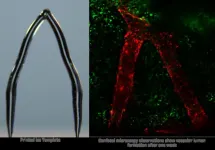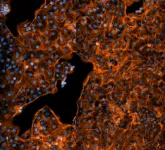(Press-News.org)
Charles Darwin – arguably the most influential man of science in history, accumulated a vast personal library throughout his working life. Until now, 85 per cent of its contents were unknown or unpublished.
This year, coinciding with Darwin’s 215th birthday, The Complete Work of Charles Darwin Online, the scholarly project helmed by Dr John van Wyhe at the National University of Singapore (NUS) Department of Biological Sciences, has released an online 300-page catalogue detailing Darwin’s complete personal library, with 7,400 titles across 13,000 volumes and items including books, pamphlets and journals. Previous lists only had 15 per cent of his whole collection. Darwin’s library has also been virtually re-assembled with 9,300 links to copies of the works freely available online.
“This unprecedentedly detailed view of Darwin’s complete library allows one to appreciate more than ever that he was not an isolated figure working alone but an expert of his time building on the sophisticated science and studies and other knowledge of thousands of people. Indeed, the size and range of works in the library makes manifest the extraordinary extent of Darwin’s research into the work of others,” said Dr van Wyhe.
Discovering Darwin’s complete library
After his death in 1882, much of Darwin’s library was preserved and catalogued, but many other items were dispersed or lost, and details of the vast majority of the contents have never been published until now. For many years, scholars have referred to Darwin’s library as containing 1,480 books, based on those that survive in the two main collections, the University of Cambridge and Down House.
Over 18 years the Darwin Online project has identified thousands of Darwin’s obscure references in his own catalogues and lists of items such as pamphlets and journals that were originally in his library. Each reference required its own detective story to discover the publications that Darwin had hurriedly recorded. In addition, missing details such as author, date or the source of clippings in thousands of records from older catalogues have been identified for the first time.
A major source of information that helped to reveal the original contents is the 426-page handwritten “Catalogue of the Library of Charles Darwin”, compiled from 1875. Painstaking comparison of its abbreviated entries revealed 440 unknown titles that were originally in the library. An inventory of his home made after his death recorded 2,065 bound books and an unknown number of unbound volumes and pamphlets. In the drawing room, 133 titles and 289 volumes of mostly unscientific literature were recorded. Amazingly, the legacy duty valuer estimated that the “Scientific Library that is books relating to Science” was worth only 30 pounds and 12 shillings [about £2,000 today] Indeed, all the books were valued at only66 pounds and 10 shillings [about £4,400 today]. Today any book that belonged to Darwin is worth a great deal to collectors.
Other sources of information that helped to build Darwin’s complete library were lists of pamphlets, Darwin’s reading notebooks, Emma Darwin’s diaries, the Catalogue of books given to the Cambridge Botany School in 1908 and the 30 volumes of the Darwin Correspondence. Items that still exist but were never included in the lists of Darwin’s library include his unbound materials at Cambridge University Library, books now in other institutional collections, private collections and books sold at auctions over the past 130 years. Combining these and many other sources of evidence allowed Darwin’s library to be reconstructed.
For example, Darwin’s copy of an 1826 article by the ornithologist John James Audubon: ‘Account of the habits of the Turkey Buzzard (Vultura aura), particularly with the view of exploding the opinion generally entertained of its extraordinary power of smelling’ was sold in 1975. Darwin had investigated this point during the voyage of the Beagle and recorded reading a critic of Audubon in the lost Galapagos notebook. In 2019, a copy of Elizabeth Gaskell’s 1880 novel Wives and daughters appeared at auction. A note in it records: “This book was a great favourite of Charles Darwin’s and the last book to be read aloud to him.”
Understanding Darwin’s library
Most of the works in Darwin’s library are, unsurprisingly, on scientific subjects, especially biology and geology. Yet, the library also included works on farming, animal breeding and behaviour, geographical distribution, philosophy, psychology, religion, and other topics that interested Darwin, such as art, history, travel and language. Most of the works are in English, but almost half are in other languages, especially German, French and Italian as well as Dutch, Danish, Spanish, Swedish and Latin.
Some of the hundreds of books not previously known to be in Darwin’s library include Sun Pictures, a 1872 coffee table book showcasing photographs of artworks. Another book that the we did not know that the Darwins purchased was a copy of the popular science book on gorillas that was all the rage just after Origin of species was published: Paul Du Chaillu’s Explorations and adventures in equatorial Africa. Of the thousands of shorter items were also found in Darwin’s library, such as an issue of a German scientific periodical sent to him in 1877 that contained the first published photographs of bacteria and another article amusingly entitled The hateful or Colorado grasshopper. In his complete library, Darwin’s eclectic sources are there for all to see.
Click to view The Complete Library of Charles Darwin
Click to view Introduction to the Library by John van Wyhe
END
11 February 2024 – EMBO and FEBS are delighted to announce that Anne Ephrussi, emerita of EMBL Heidelberg, Germany, is the recipient of this year's FEBS | EMBO Women in Science Award. It celebrates outstanding female life scientists, recognizing their research achievements and contribution to a particular discipline over the past five years in Europe. The awardees are inspiring role models who help pave the way for future generations of women in science.
“It is a huge honour and most humbling to receive the FEBS | EMBO Women in Science Award. This recognition ...
ROCKVILLE, MD – Over 100,000 individuals in the United States are currently in need of organ transplants. The demand for organs, such as hearts, kidneys, and livers, far exceeds the available supply and people sometimes wait years to receive a donated organ. Approximately 6,000 Americans die while waiting each year.
Tissue engineering to create lab-grown organs and tissues aims to close the gap between the availability of organs and the demand for transplants. But one big challenge in tissue engineering is creating blood vessel networks in artificial organs that work like natural ...
ROCKVILLE, MD – Soft robotics is the study of creating robots from soft materials, which has the advantage of flexibility and safety in human interactions. These robots are well-suited for applications ranging from medical devices to enhancing efficiency in various tasks. Additionally, using different forms of robotic movement may also serve us well in exploring the ocean or space, or doing certain jobs in those environments.
To broaden our understanding of locomotion, Richard Desatnik, who works in the labs of Philip LeDuc ...
ROCKVILLE, MD – Many premature infants need mechanical ventilation to breathe. However, prolonged ventilation can lead to problems like respiratory diseases or ventilation-induced injury.
Jonas Naumann and Mareike Zink study the physics of mechanical stress from ventilation at Leipzig University, in Leipzig, Germany and discovered some of the mechanisms that explain why premature lungs are especially sensitive to stress. Naumann will present their research at the 68th Biophysical Society Annual Meeting, to be held February 10 - 14, 2024 in Philadelphia, Pennsylvania.
When you breathe normally, your diaphragm and the muscles between ribs create a negative pressure inside the ...
ROCKVILLE, MD – Improving the way scientists can see the microscopic structures of the brain can improve our understanding of a host of brain diseases, like Alzheimer’s or multiple sclerosis. Studying these diseases is challenging and has been limited by accuracy of available models.
To see the smallest parts of cells, scientists often use a technique called electron microscopy. Electron microscopy historically involves adding chemicals and physically cutting the tissue. However, this approach can change the way the cells and structures look, perturbing their natural state, and can limit resolution. ...
ROCKVILLE, MD – Mpox, formerly known as monkeypox, is a rare viral disease that is spread through physical contact between people. Currently, testing for mpox requires lab equipment and can take a few hours to get test results. But new research suggests a way for faster testing that could be done in any clinic soon.
Md. Ahasan Ahamed, a graduate student mentored by Weihua Guan at Pennsylvania State University will present this research at the 68th Biophysical Society Annual Meeting, to be held February 10 - 14, 2024 in Philadelphia, Pennsylvania.
Though mpox symptoms are generally mild with fever, rash, and swollen lymph nodes, severe cases can occur and require medical attention. ...
New research by Joseph Reiner and colleagues at Virginia Commonwealth University shows promise for a urine-based test for ovarian cancer. Reiner will present their research at the 68th Biophysical Society Annual Meeting, to be held February 10 - 14, 2024 in Philadelphia, Pennsylvania.
Previous research showed that there are thousands of small molecules, called peptides, in the urine of people with ovarian cancer. While it is possible to detect those molecules using certain well-established techniques, ...
Tokyo, Japan – Researchers from Tokyo Metropolitan University have come up with a new way of rolling atomically thin sheets of atoms into “nanoscrolls.” Their unique approach uses transition metal dichalcogenide sheets with a different composition on either side, realizing a tight roll that gives scrolls down to five nanometers in diameter at the center and micrometers in length. Control over nanostructure in these scrolls promises new developments in catalysis and photovoltaic devices.
Nanotechnology is giving us new tools to control the structure of materials at ...
New test for improving population-based colorectal cancer screening
A new stool test appears to detect colorectal cancer precursors better than the current test. This could further reduce the number of new colorectal cancer cases as well as the number of people dying from the disease. A study led by the Netherlands Cancer Institute compared both tests. The results are published today in The Lancet Oncology.
Each year worldwide, approximately 1.9 million people are diagnosed with colorectal cancer, and 935,000 people ...
People who quit smoking see major gains in life expectancy after just a few years, according to a new study by University of Toronto researchers at Unity Health Toronto.
The study, published in NEJM Evidence, shows that smokers who quit smoking before age 40 can expect to live almost as long as those who never smoked. Those who quit at any age return close to never-smoker survival 10 years after quitting, and about half that benefit occurs within just three years.
“Quitting smoking is ridiculously effective in reducing ...












